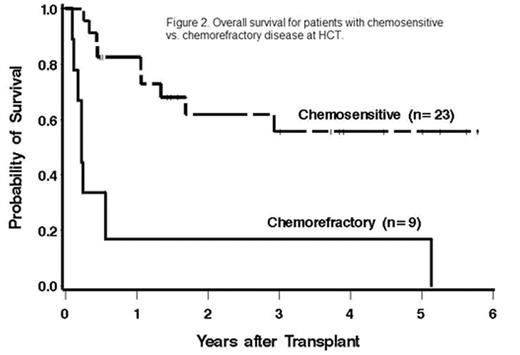Abstract
BACKGROUND: We report on outcomes after non-myeloablative allogeneic HCT in patients (pts) with relapsed DLBCL.
PATIENTS: Thirty-two pts with relapsed DLBCL were treated at 11 centers with allogeneic HCT from related (n=21) and unrelated (n=11) donors following non-myeloablative conditioning with 2 Gy total body irradiation, with or without fludarabine. Median age was 51.8 years. Twenty-four pts (75%) had undergone prior high-dose therapy (HDT) with autologous HCT: 18 (56%) had failed HDT, and 6 (19%) underwent planned tandem autologous/allogeneic HCT. The remaining 8 pts (25%) were medically ineligible for HDT. Twenty-three pts (72%) had chemosensitive disease at HCT, while 9 (28%) were chemorefractory. Disease status at HCT was complete response (CR, 14/32, 44%), partial response (PR, 9/32, 28%), or relapsed/refractory (9/32, 28%).
RESULTS: All patients engrafted. Cumulative incidences of acute GVHD grades II-IV, acute GVHD grades III-IV, and chronic GVHD were 53%, 19%, and 47%, respectively. Median follow-up of surviving patients was 45 months. Of pts with measurable disease at HCT (n=18), responses were seen in 7/18 (39%), with 6 CR’s and 1 PR. Nine of these eighteen pts progressed, and 2/18 were not evaluable due to early death from non-relapse causes. Of pts in CR at HCT, 10/14 (71%) remained in CR while 4/14 (29%) progressed. Three-year estimated overall (OS) and progression-free survival (PFS) were 45% and 35%, respectively. Three-year cumulative incidences of relapse and non-relapse mortality were 41% and 25%, respectively (see Fig. 1). In multivariate models, chemosensitive disease and receipt of >4 lines of chemotherapy prior to HCT were associated with better overall survival. Pts with chemosensitive disease at HCT had 3-year OS and PFS of 56% and 43%, respectively, while those with chemorefractory disease had 3-year OS/PFS of 11% (see Fig. 2). Prior failed or tandem autologous HCT did not have a significant effect on outcome.
CONCLUSION: Non-myeloablative allogeneic HCT can produce sustained disease responses in pts with chemosensitive relapsed DLBCL. Patients with relapsed DLBCL who have failed or are ineligible for autologous HCT lack effective therapeutic options. Non-myeloablative allogeneic HCT is a promising treatment for such patients.
Author notes
Disclosure: No relevant conflicts of interest to declare.



This feature is available to Subscribers Only
Sign In or Create an Account Close Modal